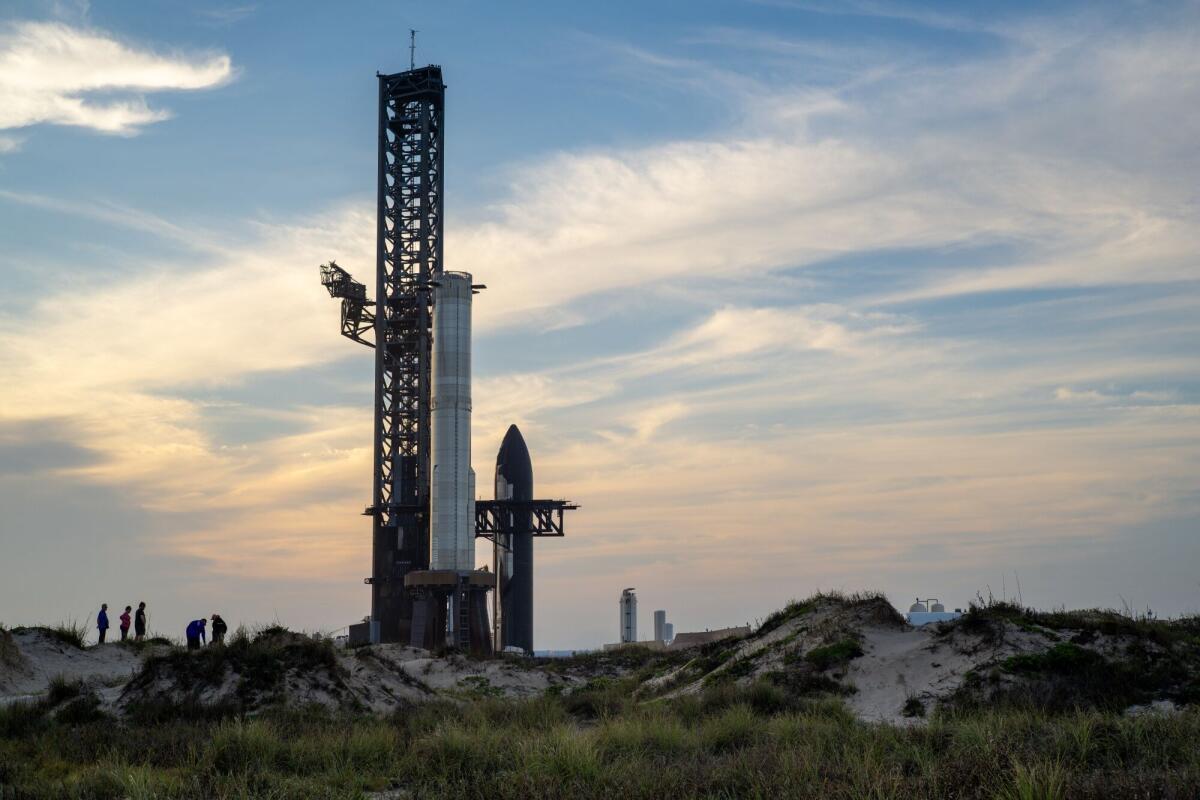SpaceX’s Starship explodes on test stand in yet another setback

- Share via
A SpaceX Starship rocket exploded on a test stand in Texas, adding to a series of setbacks to Elon Musk’s space ambitions that include trips to Mars.
The huge blast enveloped the craft as it stood upright on a test stand, before massive plumes of flames and smoke mushroomed into the night sky, video footage of the incident late Wednesday showed. The incident shook windows and rattled dishes, according to local media reports.
The rocket appeared to be undergoing a routine “static fire test” of its engines. That test is a prelaunch procedure in which a rocket’s engines are fired while the rocket remains securely held on the ground — essentially a rehearsal for the real launch, enabling engineers to test the rocket’s systems without sending it into space.
Musk said on X that a specialized bottle that holds nitrogen probably failed.
“If further investigation confirms that this is what happened, it is the first time ever for this design,” he said.
No one was injured and local residents aren’t at risk, the company said, calling the explosion “a major anomaly” as the rocket program prepared for its 10th flight test.
The apparent destruction of the rocket extends the string of mishaps for a spaceship program that’s central to NASA’s plans to put American boots back on the moon — and also to Musk’s grander ambitions to send cargo and people to Mars. The setback comes at a moment when Musk’s business empire faces falling demand for Tesla Inc.’s electric vehicles, and after Musk engaged in a public feud with President Trump.
Musk’s company holds contracts with NASA worth about $4 billion to land the agency’s astronauts on the moon using Starship, the world’s largest and most powerful launch system.
SpaceX has experienced Starship mishaps during ground testing before. The earliest Starship prototypes either collapsed or exploded during propellant tests on the ground, well before the company began conducting routine test flights with the vehicle. However, Wednesday’s explosion marked the first Starship failure in years during a ground test.
The company also has had explosive events ahead of static fire testing before. In 2016, one of the company’s SpaceX’s Falcon 9 rockets exploded as it was being loaded with propellant, a rare failure for a rocket that now boasts a more than 99% mission success rate.
SpaceX is rapidly building and testing new Starship prototypes at its Starbase test site in South Texas, meaning the company probably can slot in another craft relatively soon for the next mission. SpaceX follows a test flight regimen that entails pushing vehicles until they break to learn how they can fail, lessening the loss of any vehicle.
However, it’s another failure after a string of in-flight setbacks, making it unclear when SpaceX will start achieving many of the milestones it needs to meet to unlock the promises that Musk has made for Starship’s future.
Last month, SpaceX’s colossal Starship disintegrated midflight after spinning out of control. That loss was its third consecutive setback after flights in January and March were cut short just minutes after takeoff when the spacecraft exploded over the Gulf of Mexico, sending debris raining down from the sky and disrupting air travel.
January’s explosion was caused by a propellant leak and the March failure was triggered by a hardware problem with one of Starship’s Raptor engines, according to SpaceX.
Starship 10 hadn’t been assigned an official launch date, and it’s now unclear when the next flight will take place. After the failure of the ninth launch, SpaceX said it would carry out a data review and make improvements to the rocket system before the next test.
Aside from the failures, SpaceX celebrated some key achievements last year when Starship’s booster was first caught at the launchpad using large mechanical arms, referred to as “chopsticks.” Designed to be reusable, Starship is meant to serve as the primary spacecraft for carrying humans to Mars and then bringing them back to Earth.
Musk has said he plans to send a Starship rocket to the Red Planet carrying robots built by Tesla as early as 2026.
As the world’s richest person steps back from his political work in Washington to refocus on his business empire, it remains unclear how much time he’ll spend on Starship and SpaceX, and what changes he’ll make inside the company to get the program back on track.
Whitley , Duffy and Grush write for Bloomberg.
More to Read
Inside the business of entertainment
The Wide Shot brings you news, analysis and insights on everything from streaming wars to production — and what it all means for the future.
You may occasionally receive promotional content from the Los Angeles Times.










